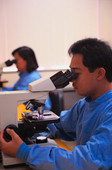
TUESDAY, Jan. 13, 2015 (HealthDay News) — Spending on medical research is waning in the United States, and this trend could have dire consequences for patients, physicians and the health care industry as a whole, a new analysis reveals.
America is losing ground to Asia, the research shows. And if left unaddressed, this decline in spending could rob the world of cures and treatments for Alzheimer’s disease, diabetes, depression and other conditions that plague the human race, said lead author Dr. Hamilton Moses III, founder and chairman of the Alerion Institute, a Virginia-based think tank.
Moses noted that a great expansion in medical research that began in the 1980s helped revolutionize cancer prevention and treatment, and turned HIV/AIDS from a fatal illness to a chronic condition.
But between 2004 and 2012, the rate of investment growth declined to 0.8 percent a year in the United States, compared with a growth rate of 6 percent a year from 1994 to 2004, the report notes.
“Common diseases that are devastating are not receiving as much of a push as would be occurring if the earlier rate of investment had been sustained,” Moses said.
America now spends about $117 billion a year on medical research, which is about 4.5 percent of the nation’s total health care expenses, the researchers report Jan. 13 in the Journal of the American Medical Association.
Cuts in government funding are the main cause for flagging investment in research, they found. Meanwhile, the share of U.S. medical research funding from private industry has increased to 58 percent in 2012, compared with 46 percent in 1994.
This has caused the United States’ total share of global research funding — both public and private — to decline from 57 percent in 2004 to 44 percent in 2012, the report noted.
While the United States still maintains its preeminence in medical research, Asian countries threaten to take the lead. Asia — particularly China — tripled investment from $2.6 billion in 2004 to $9.7 billion in 2012, according to the report.
“There’s no question we should be concerned about the U.S. decline in global investment for medical research,” said Dr. Victor Dzau, president of the Institute of Medicine of the National Academy of Sciences, who wrote an accompanying editorial. “In the direction we’re going, we’re going to lose our innovation and competitiveness globally.”
Signs of slippage are beginning to show, the authors noted. China filed 30 percent of global life science patent applications in 2011, compared with 24 percent from the United States. From 1981 to 2011, the share of “highly valuable” patents filed in the United States by American inventors decreased from 73 percent to 59 percent, while all other countries analyzed increased their share.
Losing the race to patent new medical technologies could cost Americans tremendously, Moses said.
“Scientists tend to believe that science done anywhere can be applied anywhere, but in patented advances, the mobility across borders is often restricted due to assertion of those rights,” he said. “If China or Singapore or India patents their innovations promiscuously and widely, it may limit applications, and certainly would increase the cost of those applications.”
Although the reduction in government spending has led to this decline, Moses does not believe the solution lies in the federal government.
Instead, the authors recommend a series of potential new funding sources, including:
- Changes to tax laws that would allow companies to bring money now in offshore accounts back into the United States, provided the money goes to research. “If you took 10 percent of repatriated funds, you could double, triple, quadruple the money available to research,” Moses said.
- The creation of “biomedical research bonds” floated by federal, state and local governments, similar to those used to finance airports and sports stadiums.
- Research innovation trusts that would encourage public-private partnerships in medical research, with investors receiving tax credits.
- Tax checkoffs that would allow people to specify a portion of their annual taxes go to medical research. California, Maryland, New York and Oregon already have made science a priority using tax checkoffs, the authors note.
“America has not lost its way in research,” Moses said. “We are the scientific leader by any measurement in the world. It would be ideal if the United States would maintain its momentum by bolstering its funding.”
Dzau called for a new strategic vision for research in the United States. “Whatever research and development we do, we lack an overall view of where we need to be,” he said. “We need a national strategy and a more predictable budget.”
More information
For more on government-funded research, visit the U.S. National Institutes of Health.
Copyright © 2025 HealthDay. All rights reserved.

